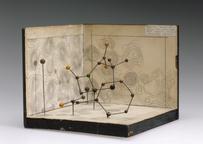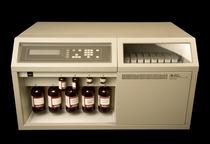





Dupont Genesis 2000 Sequencer, used together with 1995-1678 to investigate structure-function relationships in enzymes such as papaine
The Institute of Food Research investigated the protein engineering cycle. It wanted to examine the structure/function relationships in enzymes such as papain. This sequencer (seen on the left) together with the DuPont Coder 300 DNA Synthesiser was used in the investigation. The ‘Genesis 2000’ used the analytical approach developed at MIT by Walter Gilbert. It was commercialised by large chemical company DuPont. The effects of site-specific mutations were predicted using the synthesiser. They were verified in a cloned specimen using the sequencer.
Details
- Category:
- Biochemistry
- Object Number:
- 1996-310
- Measurements:
-
overall: 502 mm x 848 mm x 654 mm,
- type:
- protein sequencer
- credit:
- Institute of Food Research




